
A nebula is a distinct luminescent part of interstellar medium, which can consist of ionized, neutral, or molecular hydrogen and also cosmic dust. Nebulae are often star-forming regions, such as in the Pillars of Creation in the Eagle Nebula. In these regions, the formations of gas, dust, and other materials "clump" together to form denser regions, which attract further matter and eventually become dense enough to form stars. The remaining material is then thought to form planets and other planetary system objects.
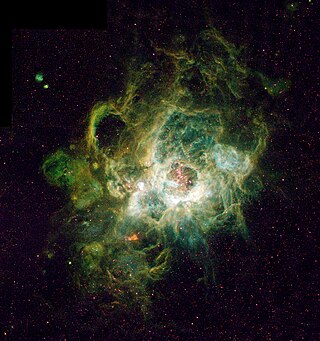
An H II region or HII region is a region of interstellar atomic hydrogen that is ionized. It is typically in a molecular cloud of partially ionized gas in which star formation has recently taken place, with a size ranging from one to hundreds of light years, and density from a few to about a million particles per cubic centimetre. The Orion Nebula, now known to be an H II region, was observed in 1610 by Nicolas-Claude Fabri de Peiresc by telescope, the first such object discovered.

The Rosette Nebula is an H II region located near one end of a giant molecular cloud in the Monoceros region of the Milky Way Galaxy. The open cluster NGC 2244 is closely associated with the nebulosity, the stars of the cluster having been formed from the nebula's matter.
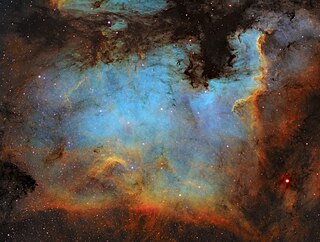
The North America Nebula is an emission nebula in the constellation Cygnus, close to Deneb. It is named because its shape resembles North America.

A starburst region is a region of space that is undergoing a large amount of star formation. A starburst is an astrophysical process that involves star formation occurring at a rate that is large compared to the rate that is typically observed. This starburst activity will consume the available interstellar gas supply over a timespan that is much shorter than the lifetime of the galaxy. For example, the nebula NGC 6334 has a star formation rate estimated to be 3600 solar masses per million years compared to the star formation rate of the entire Milky Way of about seven million solar masses per million years. Due to the high amount of star formation a starburst is usually accompanied by much higher gas pressure and a larger ratio of hydrogen cyanide to carbon monoxide emission-lines than are usually observed.

Sh 2-279 is an HII region and bright nebulae that includes a reflection nebula located in the constellation Orion. It is the northernmost part of the asterism known as Orion's Sword, lying 0.6° north of the Orion Nebula. The reflection nebula embedded in Sh 2-279 is popularly known as the Running Man Nebula.

NGC 6357 is a diffuse nebula near NGC 6334 in the constellation Scorpius. The nebula contains many proto-stars shielded by dark discs of gas, and young stars wrapped in expanding "cocoons" or expanding gases surrounding these small stars. It is also known as the Lobster Nebula. This nebula was given the name War and Peace Nebula by the Midcourse Space Experiment scientists because of its appearance, which, in infrared images the bright, western part resembles a dove, while the eastern part looks like a skull. A petition by anime fans to rename it as the Madokami nebula, due to resemblance with a character, was unsuccessful.

Sh 2-155 is a diffuse nebula in the constellation Cepheus, within a larger nebula complex containing emission, reflection, and dark nebulosity. It is widely known as the Cave Nebula, though that name was applied earlier to Ced 201, a different nebula in Cepheus. Sh 2-155 is an ionized H II region with ongoing star formation activity, at an estimated distance of 725 parsecs from Earth.

NGC 2359 is an emission nebula in the constellation Canis Major. The nebula is approximately 3,670 parsecs away and 30 light-years in size. The central star is the Wolf-Rayet star WR7, an extremely hot star thought to be in a brief pre-supernova stage of evolution. It is similar in nature to the Bubble Nebula, but interactions with a nearby large molecular cloud are thought to have contributed to the more complex shape and curved bow-shock structure of Thor's Helmet.
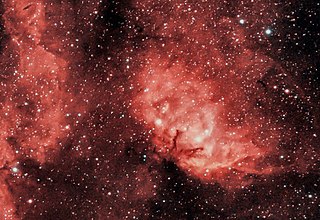
Sharpless 101 (Sh 2-101) is a H II region emission nebula located in the constellation Cygnus. It is sometimes also called the Tulip Nebula because it appears to resemble the outline of a tulip when imaged photographically. It was catalogued by astronomer Stewart Sharpless in his 1959 catalog of nebulae. It lies at a distance of about 6,000 light-years (5.7×1016 km; 3.5×1016 mi) from Earth.

RCW 120 is an emission nebula and H II region in the southern Milky Way and located some 4,300 light-years from Earth.

Sh 2-106, also known as the Celestial Snow Angel, is an emission nebula and a star formation region in the constellation Cygnus. It is a H II region estimated to be around 2,000 light years from Earth, in an isolated area of the Milky Way

Sh 2-1, also known as Sharpless 1, is the combination of a diffuse HII emission nebula and reflection nebula in the constellation of Scorpius with Pi Scorpii at its center. It appears as a modest brightness making it one of the easier Sharpless catalog objects for amateur astronomers to view. It features an apparent central star inside the nebulosity however it is not part its system nor a left over remnant.

Westerhout 40 or W40 is a star-forming region in the Milky Way located in the constellation Serpens. In this region, interstellar gas forming a diffuse nebula surrounds a cluster of several hundred new-born stars. The distance to W40 is 436 ± 9 pc, making it one of the closest sites of formation of high-mass O-type and B-type stars. The ionizing radiation from the massive OB stars has created an H II region, which has an hour-glass morphology.

Vulpecula OB1 is an OB association in which a batch of massive stars are being born. It was first identified by W. W. Morgan et al. (1953). The association is located in the Orion Arm about 7,500 light-years away from the Sun. Nebulae that are contained in this association include NGC 6820 and NGC 6823, plus Sharpless 2-88.
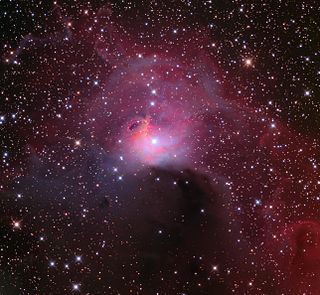
Sh 2-297 is an emission nebula in the constellation Canis Major. The region was catalogued in 1959 in the extended seconded edition of the Sharpless catalogue. This area is part of the Canis Major OB1 Association, and is a very active area of new star formation.
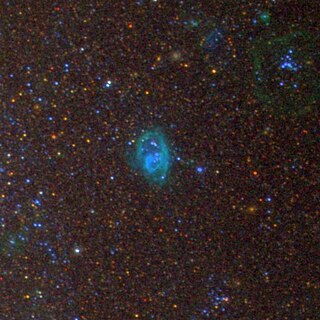
NGC 588 is a prominent, giant H II ionized diffuse nebula located in the outskirts of the galaxy Messier 33's spiral arms, within the Triangulum constellation. The nebula has two Wolf-Rayet stars, NGC 588-UIT 008 and NGC 588-MC3 and a fairly large population of main sequence stars of 2 to 20 solar masses. The more massive stars in the nebula have a mass of around 40 solar masses. NGC 588 is 4.2 million years old and has a mass of 2300 solar masses.
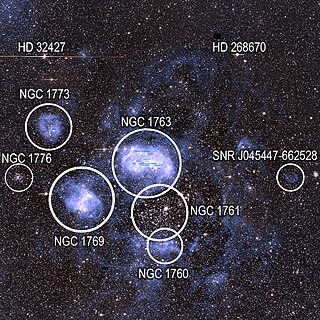
N11 is the brightest emission nebula in the north-west part of the Large Magellanic Cloud in the Dorado constellation. The N11 complex is the second largest H II region of that galaxy, the largest being the Tarantula Nebula. It covers an area approximately 6 arc minutes across. It has an elliptical shape and consists of a large bubble, generally clear interstellar area, surrounded by nine large nebulae. It was named by Karl Henize in 1956.
Sh 2-7 is an emission nebula in the Scorpius constellation. The nebula is around the star Delta Scorpii. It lies next to a large reflection nebula, Sh 2-1.
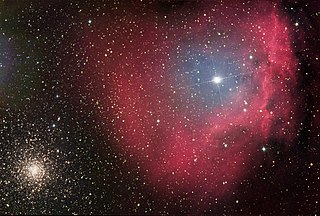
Sh 2-9, also known as Gum 65, is combination emission and reflection nebula in the Scorpius constellation, surrounding the multiple star system Sigma Scorpii. Sigma Scorpii is 1° to the northwest of Messier 4, and the nebula can be easily seen with small telescopes.



















